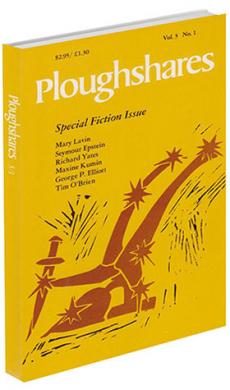rev. of Amazon One by M.F. Beal
M. F. Beal's long visionary story "Gold" was featured in the
New American Review in 1971. That piece, along with others in earlier issues of
NAR, the
Atlantic, and the
Paris Review, earned for her a considerable reputation, including mention in
Gravity's Rainbow.
Amazon One is Beal's first published novel, and will, it is to be hoped, introduce her talents to a wider audience. Neither Beal's challenging use of contemporary material, nor her remarkable insights into that material, should go unnoticed.
The novel follows one catastrophic month in the lives of several radical activists. The chapters are designated as days — April First, April Second, etc. — and within most chapters further separations are marked with notations of the time — 1:14 AM EST; 12:15 AM PST — creating an undeniable sense of urgency. The book's opening episode involves an escape; immediately the reader is shown that radical activity is "damn . . . hard . . . work," and the struggle of escape (including the most radical escape of all, from the many threatening dead ends of the self) is the book's dramatic mainspring. Six activists, sharing a house in Berkeley, are planning to "kidnap property" — plant time bombs in banks. The men of the commune are killed in an — apparently — accidental explosion while arming the devices. The house's three women then begin to run — from the law and towards a probing recognition of the reasons for their revolutionary activity.
There should be no doubt as to Beal's loyalties in this novel:
hold the line somewhere against that type of craziness which saw the future as a well-oiled machine solider-anting the universe (as it had nibbled the moon so her father could have 1.64 grams of dust to analyze) . . .
from the opening episode,
The country was committed to violence; it was the only message of intent the rulers listened to.
from the climatic Mayday chapter, and
Finally, she wanted to waken righteousness, belief in the justice of the cause to which everyone must quite consciously pledge her or himself. .
again from the final chapter. Evidently then this is the fiction of a radicalized consciousness. I speak not for Beal but for her fiction. She herself has claimed – in a note in
NAR #7 – that there are only a very small number of authors "writing about the Revolution" in the same way as she and her husband (Foley award-winner David Shetzline). It is best however to leave off questioning Beal's personal feelings and understand simply that this novel proceeds from certain tenets: its characters stand on opposing sides of the political rope and play deadly tug of war; its heroes are recognized by their disenfranchisement and their opposition to the established.
Such an aesthetic imposes two principal obligations on the author. First, the characters must be absolutely convincing, and second, the writing must be precise and physical as possible. Two moments from the novel should serve to explain why. In the first incident, one of the men later killed in the explosion, a Chicano, explains to one of the women what is wrong with her conception of the life of a grape laborer: "Chico:
You got that out of Steinbeck. It's bool sheet." The reference is I think self-conscious. M. F. Beal does not want to share the wrongheaded utopian populist vision that has become associated with Steinbeck (and, sadly, by extension, with all realistic fiction about the lower class). She recognizes the danger of using too heavy a rhetorical hand, reducing her story to sententiousness and Statement. On the contrary, Beal wants to render contemporary sicknesses wholly real:
She wanted to scream: if you're the best, why can't you do it? Do it: meaning, rationalize for the rest of us, make it concrete so we can see, hear, feel, taste, smell.
Amazon One rises to this demand – to Do It – by means of its special, compact, and determined sentences, to be sure, but especially by means of its extraordinary characters.
The fugitive women in
Amazon One are as vivid as any in recent literature. I was reminded both of Marquez's heroines in
One Hundred Years of Solitude and of such more conventional, though no less expert, portraits as those in Salinger or Bellow. One woman believes she can steal back her own child and somehow conceal crime with crime; another is eviscerated by guilt as throughly as with a corkscrew. C. B., Marina Karsh, Kam-all remind us what a rare and difficult thing it is to write well about genuine poverty and hardship. We are taken into women's prisons and taken hitchiking, into interrogations, crashpads, Dexedrine rushes, but the view never clouds over with bathos or gratuitous sensationalism. Nor does Beal limit herself to a single age or level of society. Indeed, the best writing in the book may be the description of Marina Karsh's rich, cosmopolitan, middle-aged father.
Of all
Amazon One's themes, none is sounded so often or so variously as that of defining the self. Each character develops towards a very personal end, the plot lends urgency to their search, and the organization of images emphasizes the women's separation and need for definition. In addition, given the situation, the only self finally to satisfy that need must be solitary, rigorous, and war-like – an Amazon one. Again, from the opening episode:
but it kept you
knowing what was at stake; which was of course not to face them, that was not your job at all, but rather to hold the line somewhere against that type of craziness which saw the future as a welloiled machine . . .
It is Kam, more than any other character here, who succeeds in forging such an identity. In the book's central scene (taking place, center-book and center-month, on April 15th) Kam confronts her father. At her family's dinner table, incidentally, she is not Kam but Heritage, a change which reflects the painstaking, intelligent concern Beal has for all her eponyms. The confrontation between father and daughter spares the reader the usual lugubrious slapping around and screaming – Beal hoards her violence, letting it out only at its most furious and most effective. Instead Kam and her father speak tentatively and circuitously in the dining room late at night, and Kam simply comes to see the chill distances which have opened up with her independence, with the difference between Heritage and Kam:
She began, finding herself shaping a series of facts, happenings, with curious omissions in strange places. . . . She wanted to share everything, but her mouth would not shape the words. Nor could she look at him. . . . It was. . . that things which seemed so right were appropriate because of tremendous complexes of people, events, moods, ideas, and physical environments, and once the moment passed it was lost forever . . . There were no words to describe . . . now, trying to explain to Dick became an intellectual exercise, degenerating to a matter of picking the most reasonable story and arguing it; nobody would ever know what really happened.
To give the search imagistic shape, Beal makes use of fake ID's, Wanted posters, resemblances to rock or movie stars, straight-looking photographs taken to fool parents, and the clothes each woman associates with herself. The book opens with a series of "Documents"-more Wanted posters, more ID's – that, as well as introducing the characters and their situation, give visible form to this concern for a new definition, one other than the kind given on such Documents. Two of the tools Kam uses in the book are particularly apt. In the opening episode, she is spray-painting an unlisted number on the front of a Bank of America. Near the end, she discovers again that same spray can, in the rubble where her house had formerly stood; in her pack she carries a .45 that later she will clean and prepare for firing. The can is burned black and has lost its nozzle – an impotent child's toy compared to the destructive, final revolver she carries now.
The entire novel depends on a gap having been suddenly pitched open. Where a house was standing now is a hole. Where before I was Heritage now I am Kam. Where before I was safe now I am in danger. This sudden irrevocable and intraversable distance from where one has formerly stood is to be sure intrinsic to the process of defining one's identity, and nothing in
Amazon One is perceived except in these sort of essential terms. For all that its surface is contemporary, the book's seers are Maimonides and the
I Ching; dark menstrual blood is its deepest stain. At the same time Beal's understanding of "curious omissions in strange places," of there being "no words to describe," of, in short, the emotional result of painful rifts in our culture is a genuine insight into the times. Along with that of Robert Stone, Robert Pirsig, and Ann Beattie, this is the first fiction of the revolutionary consciousness that seems to me destined to last. We have had far too much hypocritical, empty-headed glossiness like
Do It!, Steal This Book, or
With the Weathermen. Amazon One is more than any of them: fine, thoughtful, uncompromising, humane.



